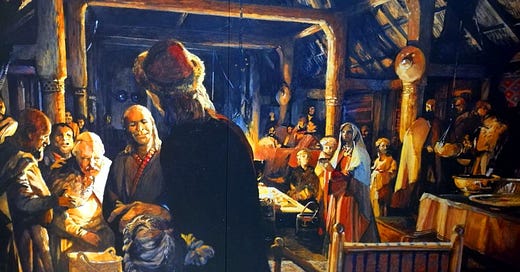Imagine the scene. The Anglo-Saxon villagers have come together in the mead-hall. Sitting around a fire blazing in the centre of the room. All ages are present there; young and old. All sharing in this together. All eager to hear the stories they have heard so many times before.
The ‘scop’ (Anglo-Saxon storyteller) stands up amongst the assembly. He is an older man, dressed for the occasion. He draws a deep breath and begins to recite the night’s story. Maybe it will be about Beowulf the brave hero, perhaps the story of Christ and Satan or the poem called ‘The Wanderer’.
This would have been a regular event in Anglo-Saxon life. As with many ancient cultures, oral tradition was important for remembering the history and the myths which kept them community together and close knit.
The storyteller would employ special literary techniques to bring the story to life. These included:
Metaphors
Similes
Alliteration (a repetition of the initial consonant sound, e.g. rare, red-skinned rabbits)
Caesura (a pause)
Kenning (a descriptive phrase creating a compound word, e.g. sky-tears = rain)
Repetition
The Anglo-Saxons were not wild barbarians, but had an awareness of complex literary techniques. And even today, their poetry can be appreciated.
In Beowulf, the famous Anglo-Saxon epic, we see a ‘scop’ mentioned:
A man of celebrity, mindful of rhythms, who ancient traditions treasured in memory, new word-groups found properly bound
Here, the scop is someone who is famous. He recites the traditional stories, and uses kennings, alliterations and other techniques (word-groups found properly bound) to enhance them.
So at each retelling of the story, through an iterative process, the scop would improve and adapt the stories. They would become more engaging and pleasing to the hearers. The main elements of the story would not necessarily change, but the delivery would.
Maybe the scop would add a new kenning or a different alliteration. Maybe a pause would be in a different place than usual to add tension. The scop would feel the room and keep the changes that worked and so enhance the next delivery of the story.
Below is a list of kennings and alliterations found in Beowulf. This gives a flavour of the literary devices within the text.
battle-sweat = blood
sleep of the sword = death
raven-harvest = a corpse/corpses
sky-candle = the sun
to feast his fill of the flesh of men
for fear of a feud were forced to disown him
Hrothgar’s men lived happy in his hall
So when we come to Genesis A+B, we see the same techniques employed. The scops took the original Biblical text and embellished it so they could add it to the rich canon of Anglo-Saxon oral tradition.
Here is a list of the kennings and alliteration used in the text I shared with you in my last post:
Glory-King
truth-fast
treasure-strong
Head of all High-Creation
the bright bliss of their creator
we wordfully praise the Heavens’ Ward
As we continue to journey through Genesis A+B, I hope, like me, you will see the literary beauty in this text.





Really enjoyed this. Excellent description. 👍
Really enjoying this one Alex!